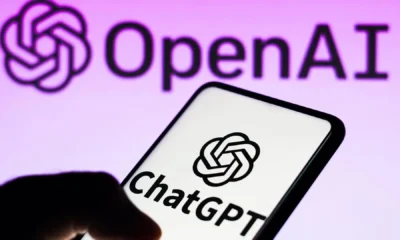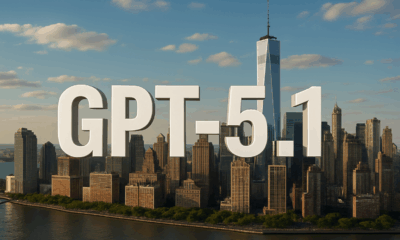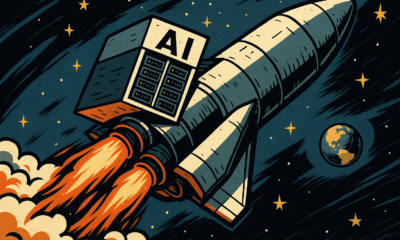News
Nano Banana 2: How Google’s Next-Gen Visual AI Could Redefine Image Creation

- Share
- Tweet /data/web/virtuals/375883/virtual/www/domains/spaisee.com/wp-content/plugins/mvp-social-buttons/mvp-social-buttons.php on line 63
https://spaisee.com/wp-content/uploads/2025/11/nana_banana_2.png&description=Nano Banana 2: How Google’s Next-Gen Visual AI Could Redefine Image Creation', 'pinterestShare', 'width=750,height=350'); return false;" title="Pin This Post">
When your phone’s camera just won’t cut it anymore, imagine an AI that doesn’t just capture an image—it understands the scene, edits your face, changes style, and generates storyboards—all in under ten seconds. That’s where Nano Banana 2 is aiming.
What Is Nano Banana 2?
The term “Nano Banana” originally referred to Nano Banana (codename for Google’s Gemini 2.5 Flash Image model), a viral image-generation and editing tool inside Gemini that let users transform selfies into stylised figurines and carry out photo-editing with natural-language prompts.
Now, the upcoming upgrade—Nano Banana 2 (internally codenamed GEMPIX2)—promises to be far more than a novelty. Early reporting suggests it will be built on Gemini 3 Pro Image and aims at a major leap in fidelity, semantics and integration.
Key Upgrades to Watch
According to leaked documentation, developer notes and media analysis, the following are expected features in Nano Banana 2:
Higher resolution & aspect-ratio flexibility. While the original largely generated square images at moderate resolution, this upgrade is reported to support native 2K renders and 4K up-scaling, plus multiple aspect-ratios (16:9, vertical, wide).
Improved prompt-understanding and global context awareness. The model is said to better interpret nuanced prompts (e.g., “streetwear shoot in Berlin winter”) and embed culturally authentic visual detail.
Subject consistency & scene editing. Nano Banana 2 reportedly allows the same character or object to be tracked across multiple images, so a subject’s outfit, pose or lighting remains coherent in sequential scenes. The editing mode goes beyond creation: you can refine existing images (“edit with Gemini”).
Faster generation and potentially on-device inference. Early reports suggest render times dropping under 10 seconds and possibility of on-device generation (especially on Pixel devices) via smaller local-inference models.
Seamless integration into workflows. The model isn’t just a standalone toy—it appears to be plugging into Google’s broader ecosystem: Search with Lens, Photos, Workspace apps, and possibly mobile cameras.
Why This Matters
For creators, marketers and businesses this is significant. With higher fidelity and speed, the barrier to producing professional-quality visuals drops further. A designer might generate campaign assets directly from a prompt. A mobile app could let users redesign rooms, change looks or create branded imagery in seconds. The transition from “playful toy” to “productive tool” is the crux.
On the consumer side, it means the visual-editing expectation moves: what once required Photoshop and hours of work could become instant. That affects social media, content generation, influencer workflows and even everyday photography.
At the ecosystem level, Google is signalling that generative visual AI isn’t just for experiments—it’s core product infrastructure. Integrations into Search, Lens and Photos suggest the model will impact how average users consume and create images, not just power exotic demos.
Challenges & Considerations
Even with impressive specs, Nano Banana 2 won’t be flawless or without trade-offs. Some potential issues:
Quality vs. speed trade-offs. Generating ultra-high-fidelity 4K images quickly still demands significant compute. On-device generation may only apply to constrained use cases.
Bias and cultural limitation. While the model touts “global context awareness,” training data often skews Western, meaning representation of under-served regions might still lag.
Ownership and use rights. As these tools become more mainstream, questions around who owns generated images (user vs. model vs. platform) become urgent.
Deep-fakes and misuse. More powerful image generation and editing raises concerns around misinformation, identity misuse and manipulative visuals. Google has described watermarking via SynthID for Nano Banana v1.
Timeline & Availability
While Google has not formally announced a public release date, multiple sources point to a limited rollout around mid-November 2025, with broader integration into Google’s ecosystem (Photos, Workspace, etc.) expected in early 2026.
The initial version may surface in mobile apps (Gemini app, Google Photos), followed by API access for enterprise/creators.
What to Look for Next
To track this rollout and its implications:
- Watch for official announcements from Google or DeepMind about GEMPIX2 / Nano Banana 2.
- Observe new features in the Gemini app, Google Lens “Create” mode, Google Photos generative tab.
- Check for early creator tests: how well the model handles typography, multi-scene coherence, and unusual aspect ratios.
- Monitor pricing and API terms: Will Google open this widely or restrict to premium users/partners?
- Evaluate how competitors respond. For example, rivals such as Seedream 4.0 are reportedly targeting the same space.
Verdict
Nano Banana 2 appears to be less about hype and more about foundational change in generative visual AI. It is poised to move from fun edits and viral figurines to a serious creative platform embedded in everyday tools. If it delivers on resolution, prompt-understanding, speed and integration, we may see a shift where generating visual assets becomes as natural as writing a paragraph.
For creators, brands and AI adopters, it’s a prompt: think ahead. Consider workflows where image generation, editing and consistency matter. Build around visual-AI from the start rather than bolt it on later.
In short, Nano Banana 2 may well become the image-generation backbone for the next wave of digital creativity—not just for artists, but for any platform that works with visuals.
News
Jeff Bezos Returns to the Helm: Co‑CEO Role at Project Prometheus Signals AI’s Next Industrial Wave

After stepping back from frontline leadership at Amazon, Jeff Bezos is re‑emerging in full force—this time as co‑chief executive of a multimillion‑dollar AI effort aimed not at consumer apps, but the very machines that build machines.
A Comeback With a Twist
Jeff Bezos is taking a formal operational role again, co‑leading the newly revealed startup Project Prometheus alongside physicist‑chemist and tech veteran Vik Bajaj. The company has already secured around $6.2 billion in funding and recruited nearly 100 employees drawn from firms like OpenAI, DeepMind and Meta Platforms.
Rather than targeting the consumer‑facing layers of AI, Project Prometheus is reportedly built around “AI for the physical economy”—engineering systems for computers, automobiles and aerospace manufacturing. It is a stark contrast to many headline‑grabbing models built for chat, images or games.
Why This Shift Matters
Bezos’s reentry is notable for several reasons. First, he is betting on enterprise‑scale AI infrastructure rather than the hype‑driven consumer sandbox. By focusing on manufacturing, design and physical systems, the venture hints at where the next frontier of commercial AI might lie.
Second, the sheer size of the initial capital and speed of talent acquisition suggest that investors believe the AI race is evolving from model size and training datasets to execution, hardware‑integration and industrial adaptation. The physical economy—where design, simulation, production and robotics converge—presents massive revenue potential, but also complex operational challenges.
Third, the move reflects a broader trend in which the most ambitious AI plays are shifting from speculative applications to tangible systems with long lead‑times, regulation, physical supply chains and measurable outcomes. In doing so, Project Prometheus positions itself not simply as another AI startup, but as a possible infrastructure supplier to the next wave of industry transformation.
Strategic Implications for Tech and Crypto
For traditional tech: The race is no longer solely about who can build the biggest model or capture the largest consumer audience. The heavy‑lifting real world—manufacturing, aerospace, automobiles—may become the battleground for differentiation, safety and durability.
For crypto and Web3: As industry infrastructure becomes more AI‑driven, protocols and token models may need to integrate not just software logic, but hardware, simulation and physical asset workflows. Projects that link AI to real‑world machines and processes could gain an edge.
For investors: The narrative may be shifting from edge‑cutting consumer tech to long‑cycle, high‑barrier projects where upfront capital and integrated ecosystems matter. Betting on infrastructure could lead to slower returns—but perhaps lower risk than chasing viral apps.
Risks and Open Questions
Despite the bold announcement, many details remain opaque. The actual technology roadmap, monetisation strategy and competitive differentiation of Project Prometheus have not been disclosed. In a crowded AI field—with giants like Google‑Alphabet, Microsoft‑backed entities and open‑source ecosystems racing—execution will matter more than intention.
Scaling AI in the physical economy means hardware integration, simulation accuracy, real‑world testing, regulatory compliance and industrial adoption—challenges that exceed those in purely digital applications. Failures in any of these domains could significantly delay progress.
Moreover, market expectations may prove unforgiving. A large upfront raise and public announcement raise the bar; if the venture underdelivers, perception could sour quickly. In an era where AI hype often precedes utility, credibility will depend on tangible outcomes, not headlines.
Final Thought
Jeff Bezos stepping back into a leadership role signals that the AI industry may be entering a new phase—from flamboyant consumer experiments to serious infrastructure plays. Project Prometheus may set the tone for what “AI done right” looks like when it connects machine intelligence to the physical systems that build our world. Whether it succeeds or stumbles, the era it represents is already underway.
News
Microsoft’s Next Big AI Bet: Building a “Humanist Superintelligence”

In a moment when tech giants tout general-purpose AI as an inevitable future, Microsoft is intentionally shifting gears — committing to an advanced intelligence that serves humanity first, not replaces it.
A New Team, A New Vision
Microsoft has announced the formation of a dedicated unit called the MAI Superintelligence Team, led by Mustafa Suleyman. This group is tasked with developing what Microsoft calls a “humanist superintelligence” — a system that isn’t just powerful, but grounded in human values, human oversight, and real-world benefit.
The company emphasized that it is not chasing “an unbounded and unlimited entity with high degrees of autonomy.” Instead, the vision is to build domain-specific AI with superhuman performance that remains explicitly designed to serve human interests.
Why This Matters
The broader AI race has often focused on scale and versatility — building models that can generate code, write essays, answer questions, and play games with near-human capability. Microsoft’s move signals a deliberate shift away from capability for capability’s sake. This is a strategic bet on alignment: that the most valuable AI in the long run will not be the most powerful, but the most controllable, useful, and socially integrated.
Rather than competing solely in benchmark scores or model size, Microsoft is targeting real-world domains like healthcare, education, and climate — high-stakes environments where trust, accuracy, and compliance matter as much as performance.
For sectors like crypto and finance that are increasingly AI-adjacent, this change in narrative matters. As both fields converge around infrastructure, governance, and automation, questions of safety, mission alignment, and systemic impact become harder to ignore.
Strategic Implications for the Tech Ecosystem
For enterprise AI builders, this shift reframes the mission. It’s no longer sufficient to ask what an AI system can do; teams must now consider what it should do, how it’s governed, and what risks it introduces. Microsoft’s vision pushes developers toward frameworks that embed accountability and value-alignment from the start.
For Web3 and crypto projects, the implications are equally critical. Many blockchain initiatives aim to integrate AI — either through data marketplaces, decentralized compute, or autonomous agents. But if AI systems are heading toward regulatory scrutiny and value-aligned architecture, protocols will need to follow suit. A purely autonomous system, if unaligned or opaque, may be seen less as innovative and more as risky.
For investors, this is a signal that the market narrative is evolving. Early rounds favored novelty and raw model performance. The next wave could reward those who prioritize controllability, long-term stability, and integration with regulated industries.
Challenges on the Horizon
The vision is bold, but the path is complex. Designing AI systems that outperform humans in specific domains while remaining safe and controlled is an unsolved challenge. Containment and alignment are not just technical hurdles; they’re philosophical and operational ones too.
Microsoft admits this: it sees the design of alignment frameworks as one of the most urgent challenges in AI development. And by positioning itself as a leader in ethical deployment, the company may take on slower development timelines or higher infrastructure costs compared to more aggressive, less restrained competitors.
The bet here is long-term — and it may run counter to the pace of the current AI investment frenzy.
Final Thought
Microsoft’s pivot toward “humanist superintelligence” offers more than a branding exercise. It’s a real-time reflection of where the AI conversation is heading: away from raw horsepower and toward systems that align with human values, institutional frameworks, and societal needs.
In doing so, Microsoft is challenging the narrative that AI progress is solely about power and scale. It is putting forth a counter-thesis — that in a future defined by automation, trust and alignment might be the real differentiators. If it’s right, this could redefine how AI systems are evaluated, regulated, and deployed across every industry that touches data, decision-making, or infrastructure.
News
The AI Bubble Nears Its Breaking Point—And the Aftershock Could Redefine Tech

All the signs are flashing red. After years of unchecked hype and enormous capital flows, the artificial‑intelligence boom is showing unmistakable signs of strain—and when the bubble bursts, it could shake not just tech portfolios but entire economies.
A Bubble Reinforced by Hype
The current surge in artificial‑intelligence investment is unprecedented: nearly half of global private‑equity flows are now directed into AI‑related firms, and the technology sector increasingly underpins major stock‑market indices. Many of these companies lack proven revenue models or sustainable business cases, yet valuations have soared regardless. The pattern echoes the early stages of the 2000s dot‑com bubble, where optimism outpaced operational reality.
Why This Time Might Be Different
Unlike previous tech cycles, the AI wave is already deeply embedded in numerous industries—from cloud infrastructure and data centres to chip manufacturing and enterprise‑software platforms. The infrastructure demands are immense, with rapidly depreciating hardware, intense energy needs, and limited margins in many segments. This complexity means that if confidence turns, the contraction may be broader and more rapid than past bubbles.
Implications for Investors and Corporations
For investors, the message is clear: runaway valuations and speculative business models may now expose portfolios to greater downside risk than ever before. For corporations, the challenge is moving from experimentation to monetisation—without a meaningful shift to profit, many AI plays risk being labeled as hype rather than innovation. A collapse could force a reassessment of capital flows, valuations and what success in AI actually means.
The Road Ahead
The next 12 to 24 months will be critical. If performance fails to match promise, we could see a market reset driven by investors re‑thinking the cost‑benefit calculus of AI bets. On the other hand, firms that demonstrate clarity in value‑creation—either by delivering profitability or reshaping business models—may emerge as winners even as the broader landscape recalibrates.
-

 AI Model1 month ago
AI Model1 month agoHow to Use Sora 2: The Complete Guide to Text‑to‑Video Magic
-

 AI Model3 months ago
AI Model3 months agoTutorial: How to Enable and Use ChatGPT’s New Agent Functionality and Create Reusable Prompts
-

 AI Model5 months ago
AI Model5 months agoComplete Guide to AI Image Generation Using DALL·E 3
-

 AI Model5 months ago
AI Model5 months agoMastering Visual Storytelling with DALL·E 3: A Professional Guide to Advanced Image Generation
-

 AI Model3 months ago
AI Model3 months agoTutorial: Mastering Painting Images with Grok Imagine
-

 News2 months ago
News2 months agoOpenAI’s Bold Bet: A TikTok‑Style App with Sora 2 at Its Core
-

 News4 months ago
News4 months agoAnthropic Tightens Claude Code Usage Limits Without Warning
-

 News1 month ago
News1 month agoGoogle’s CodeMender: The AI Agent That Writes Its Own Security Patches











